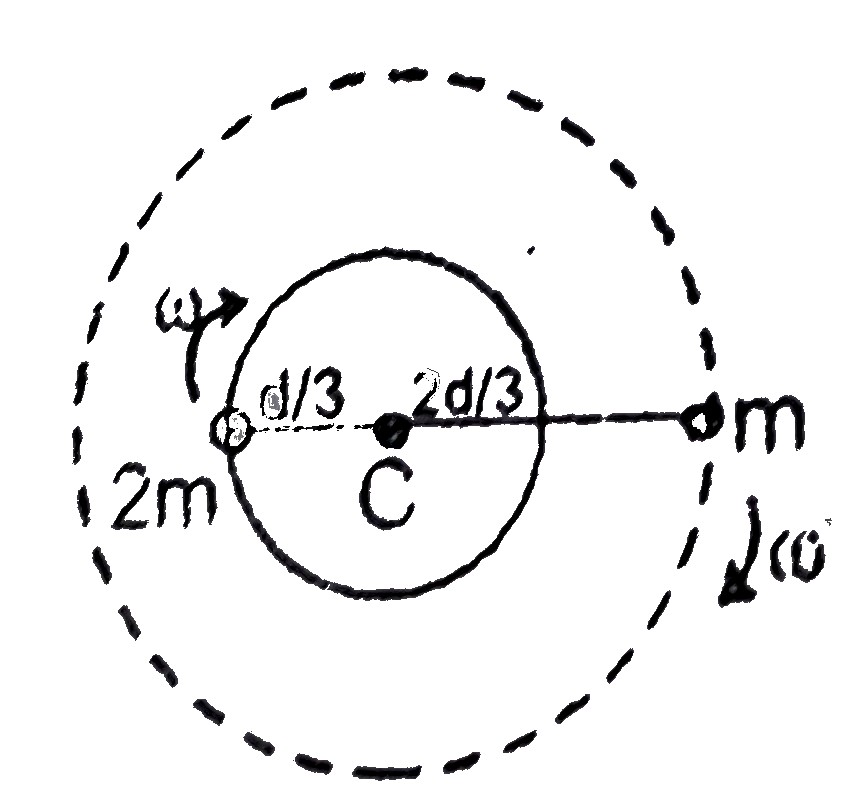In a double star, two stars one of mass m1 and another of mass m2, with a separation d, rotate about their common centre of mass. Find
(a) an expression for their time period of revolution.
(b) the ratio of their kinetic energies.
(c) the ratio of their angular momenta about the centre of mass.
(d) the total angular momentum of the system.
(e) the kinetic energy of the system.
The centre of mass C will be at distances d/3 and 2d/3 from the masses 2m and m respectively Both the stars rotate round C in their respective orbits with the same angular velocity ω the gravitational force acting on each star due to the other supplies the necessary centripetal force The gravitational force on either star is G(2m)md2 If we consider the rotation of the smaller star, the centripetal force (mrω2)is[m(2d3)ω2] and for bigger star [2mdω23] i.e same
∴G(2m)md2=m(2d3)ω2 or ω=√3gmd3
Therefore, the period of revolution is given by T=2πω=2π√d33Gm
The ratio of the angular momentum is (Iω)big(iω)small=IbigIsmall=(2m)(d3)2m(2d3)2=12
since ω is same for both The ratio of their kinetic energygies is (12Iω2)big(12Iω2)small=IbigIsmall=12
which is the same as the ratio of their angular momentum .
 .
.
Topper's Solved these Questions
- BOOK - RESONANCE ENGLISHCHAPTER - GRAVITATIONEXERCISE - EXAMPLE2videos
GRAVITATION
- BOOK - RESONANCE ENGLISHCHAPTER - GRAVITATIONEXERCISE - EXERCISE-1 PART-19videos
GRAVITATION
- BOOK - RESONANCE ENGLISHCHAPTER - GRAVITATIONEXERCISE - HIGH LEVEL PROBLEMS16videos
GRAVITATION
- BOOK - RESONANCE ENGLISHCHAPTER - GEOMATRICAL OPTICS EXERCISE - Advance level Problems35videos
GEOMATRICAL OPTICS
- BOOK - RESONANCE ENGLISHCHAPTER - NUCLEAR PHYSICSEXERCISE - Advanced level solutions16videos
NUCLEAR PHYSICS
Similar Questions
In a double star system one of mass m1 and another of mass m2 with a separation d rotate about their common centre of mass. Then rate of sweeps of area of star of mass m1 to star of mass m2 about their common centre of mass is
View Solution
The angular momentum of the atom about the centre of mass will beView Solution
Knowledge Check
- Question 1 - Select One
Two stars of masses m1 and m2 distance r apart, revolve about their centre of mass. The period of revolution is :
A2π√r32G(m1+m2)B2π√r3(m1+m2)2G(m1m2)C2π√2r3G(m1+m2)D2π√r3G(m1+m2) - Question 2 - Select One
Two bodies have their moments of inertia I and 2I respectively about their axis of rotation. If their kinetic energies of rotation are equal, their angular momenta will be in the ratio.
A12B√2C1:√2D21
In a binary star system one star has thrice the mass of other. The stars rotate about their common centre of mass then :
View SolutionTwo bodies A and B having masses in the ratio of 3 : 1 possess the same kinetic energy. The ratio of their linear momenta is then
View SolutionTwo stars of masses m1 and m2 distance r apart, revolve about their centre of mass. The period of revolution is :
View SolutionTwo bodies of masses m1andm2 have same kinetic energy. The ratio of their momentum is
View Solution_E01_055_Q01.png)
For the double star system, the two stars having masses m1 and m2are separated b a distance r. They are revolving about their common centre of mass in radii r1 and r2 respectively. Which of the following is/are incorrect.?View SolutionA binary star consists of two stars A(mass2.2Ms) and B (mass11Ms) where Ms is the mass of the sun, they are separted by distane d and are rotating about their center of mass, which is stationary. The ratio of the total angular momentum of the binary to the angular momentum of star B about the centre of mass is
View Solution

